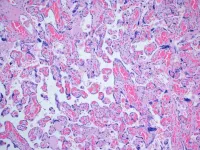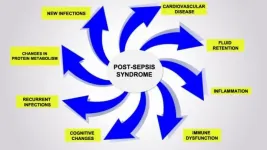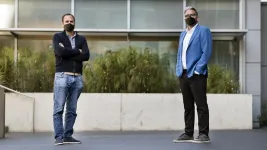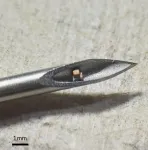(Press-News.org) Can you feel the heat? To a thermal camera, which measures infrared radiation, the heat that we can feel is visible, like the heat of a traveler in an airport with a fever or the cold of a leaky window or door in the winter.
In a paper published in Proceedings of the Royal Society A: Mathematical, Physical and Engineering Sciences, an international group of applied mathematicians and physicists, including Fernando Guevara Vasquez and Trent DeGiovanni from the University of Utah, report a theoretical way of mimicking thermal objects or making objects invisible to thermal measurements. And it doesn't require a Romulan cloaking device or Harry Potter's invisibility cloak. The research is funded by the National Science Foundation.
The method allows for fine-tuning of heat transfer even in situations where the temperature changes in time, the researchers say. One application could be to isolate a part that generates heat in a circuit (say, a power supply) to keep it from interfering with heat sensitive parts (say, a thermal camera). Another application could be in industrial processes that require accurate temperature control in both time and space, for example controlling the cooling of a material so that it crystallizes in a particular manner.
Watch a visualization of how the method cloaks a kite-shaped object here.
Or watch how it works for a Homer Simpson-shaped object here.
Cloaking or invisibility devices have long been elements of fictional stories, but in recent years scientists and engineers have explored how to bring science fiction into reality. One approach, using metamaterials, bends light in such a way as to render an object invisible.
Just as our eyes see objects if they emit or reflect light, a thermal camera can see an object if it emits or reflects infrared radiation. In mathematical terms, an object could become invisible to a thermal camera if heat sources placed around it could mimic heat transfer as if the object wasn't there.
The novelty in the team's approach is that they use heat pumps rather than specially crafted materials to hide the objects. A simple household example of a heat pump is a refrigerator: to cool groceries it pumps heat from the interior to the exterior. Using heat pumps is much more flexible than using carefully crafted materials, Guevara says. For example, the researchers can make one object or source appear as a completely different object or source. "So at least from the perspective of thermal measurements," Guevara says, "they can make an apple appear as an orange."
The researchers carried out the mathematical work needed to show that, with a ring of heat pumps around an object, it's possible to thermally hide an object or mimic the heat signature of a different object.
The work remains theoretical, Guevara says, and the simulations assume a "probing" point source of heat that would reflect or bend around the object - the thermal equivalent of a flashlight in a dark room.
The temperature of that probing source must be known ahead of time, a drawback of the work. However the approach is within reach of current technology by using small heat pumps called Peltier elements that transport heat by passing an electrical current across a metal-metal junction. Peltier elements are already widely used in consumer and industrial applications.
The researchers envision their work could be used to accurately control the temperature of an object in space and time, which has applications in protecting electronic circuits. The results, the researchers say, could also be applied to accurate drug delivery, since the mathematics of heat transfer and diffusion are similar to those of the transfer and diffusion of medications. And, they add, the mathematics of how light behaves in diffuse media such as fog could lead to applications in visual cloaking as well.
Find a preprint of the study here.
After publication, find the full study here.
In addition to Guevara and DeGiovanni, Maxence Cassier, CNRS Researcher at the Fresnel Institute in Marseille, France and Sébastien Guenneau, CNRS researcher, UMI 2004 Abraham de Moivre-CNRS, Imperial College London, London, UK co-authored the study.
INFORMATION:
A study across 55 hospitals in Queensland, Australia suggests that a recent state policy to introduce a minimum ratio of one nurse to four patients for day shifts has successfully improved patient care, with a 7% drop in the chance of death and readmission, and 3% reduction in length of stay for every one less patient a nurse has on their workload.
The study of more than 400,000 patients and 17,000 nurses in 27 hospitals that implemented the policy and 28 comparison hospitals is published in The Lancet. It is the first prospective evaluation of the ...
CHICAGO --- A new Northwestern Medicine study of placentas from patients who received the COVID-19 vaccine during pregnancy found no evidence of injury, adding to the growing literature that COVID-19 vaccines are safe in pregnancy.
"The placenta is like the black box in an airplane. If something goes wrong with a pregnancy, we usually see changes in the placenta that can help us figure out what happened," said corresponding author Dr. Jeffery Goldstein, assistant professor of pathology at Northwestern University Feinberg School of Medicine and a Northwestern Medicine pathologist. "From what we can tell, the COVID vaccine does not damage the placenta."
The study will be published May 11 in the journal Obstetrics ...
TORONTO, ON - Geoscientists at the University of Toronto (U of T) and Istanbul Technical University have discovered a new process in plate tectonics which shows that tremendous damage occurs to areas of Earth's crust long before it should be geologically altered by known plate-boundary processes, highlighting the need to amend current understandings of the planet's tectonic cycle.
Plate tectonics, an accepted theory for over 60 years that explains the geologic processes occurring below the surface of Earth, holds that its outer shell is fragmented into continent-sized blocks of solid rock, called "plates," that slide over Earth's mantle, the rocky inner layer above ...
An article published in Frontiers in Immunology suggests that sepsis can cause alterations in the functioning of defense cells that persist even after the patient is discharged from hospital. This cellular reprogramming creates a disorder the authors call post-sepsis syndrome, whose symptoms include frequent reinfections, cardiovascular alterations, cognitive disabilities, declining physical functions, and poor quality of life. The phenomenon explains why so many patients who survive sepsis die sooner after hospital discharge than patients with other diseases or suffer from post-sepsis syndrome, immunosuppression ...
COVID-19 has had a significant impact since the pandemic was declared by WHO in 2020, with over 3 million deaths and counting, Researchers and medical teams have been hard at work at developing strategies to control the spread of the infection, caused by SARS-COV-2 virus and treat affected patients. Of special interest to the global population is the developments of vaccines to boost human immunity against SARS-COV-2, which are based on our understanding of how the viral proteins work during the infection in host cells. Two vaccines, namely the Pfizer/BioINtech and Oxford/AZ vaccine rely on the use of delivering the gene that encodes the viral spike protein either as an mRNA or through an adenovirus vector to promote the production of relevant antibodies. The use of monoclonal ...
In order to make meaningful gains in cardiovascular disease care, primary care medical practices should adopt a set of care improvements specific to their practice size and type, according to a new study from the national primary care quality improvement initiative EvidenceNOW. High blood pressure and smoking are among the biggest risk factors associated with cardiovascular disease. Primary care physicians help patients manage high blood pressure and provide smoking cessation interventions.
Researchers found that there is no one central playbook for all types of practices, but they did identify ...
Although new family medicine graduates intend to provide a broader scope of practice than their senior counterparts, individual family physicians' scope of practice has been decreasing, with fewer family physicians providing basic primary care services, such pediatric and prenatal care. Russell et al conducted a study to explore family medicine graduates' attitudes and perspectives on modifiable and non-modifiable factors that influenced their scope of practice and career choices. The authors conducted five focus group discussions with 32 family physicians and explored their attitudes and perspectives on their desired and actual scope of practice. Using a conceptual framework ...
In the decade since the advent of CRISPR-Cas9 gene editing, researchers have used the technology to delete or change genes in a growing number of cell types. Now, researchers at Gladstone Institutes and UC San Francisco (UCSF) have added human monocytes--white blood cells that play key roles in the immune system--to that list.
The team has adapted CRISPR-Cas9 for use in monocytes and shown the potential utility of the technology for understanding how the human immune system fights viruses and microbes. Their results were published online today in the journal Cell Reports.
"These experiments set the stage for many more studies on the interactions between major infectious diseases and human immune cells," says senior author Alex Marson, MD, PhD, director of the Gladstone-UCSF Institute ...
Pregnant women who develop severe COVID-19 infections that require hospitalization for pneumonia and other complications may not be more likely to die from these infections than non-pregnant women. In fact, they may have significantly lower death rates than their non-pregnant counterparts. That is the finding of a new study published today in the Annals of Internal Medicine conducted by researchers at the University of Maryland School of Medicine (UMSOM).
The study examined medical records from nearly 1,100 pregnant women and more than 9,800 non-pregnant patients aged 15 to 45 who were hospitalized with COVID-19 and pneumonia. Slightly less than 1 percent of the pregnant patients died from COVID-19 compared to 3.5 percent of non-pregnant patients, according to the study findings.
There ...
New York, NY--May 11, 2021--Widely used to monitor and map biological signals, to support and enhance physiological functions, and to treat diseases, implantable medical devices are transforming healthcare and improving the quality of life for millions of people. Researchers are increasingly interested in designing wireless, miniaturized implantable medical devices for in vivo and in situ physiological monitoring. These devices could be used to monitor physiological conditions, such as temperature, blood pressure, glucose, and respiration for both diagnostic and therapeutic ...



